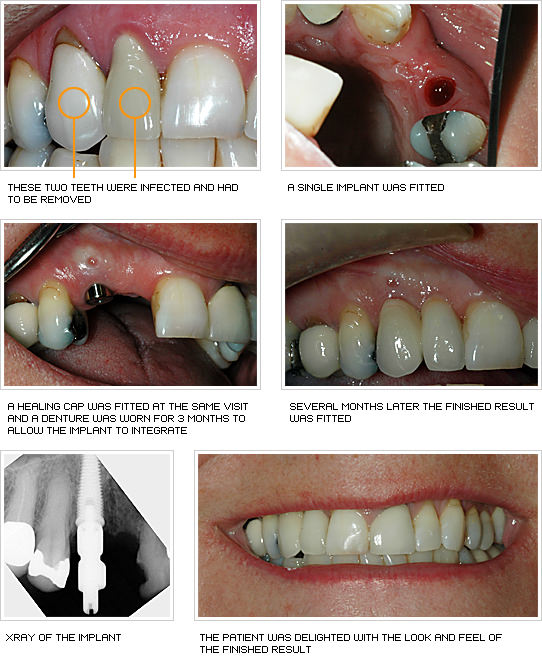Dental Sense for Beginners
Table of ContentsThe Greatest Guide To Dental SenseThe Definitive Guide to Dental SenseGetting My Dental Sense To WorkThe 8-Second Trick For Dental Sense
are clinical devices surgically dental implanted into the jaw to recover a person's capability to eat or their appearance. They supply support for artificial (fake) teeth, such as crowns, bridges, or dentures. When a tooth is shed as a result of injury or illness, a person can experience complications such as rapid bone loss, defective speech, or adjustments to chewing patterns that lead to discomfort.Oral implant systems contain an oral implant body and dental implant abutment and might also include a joint fixation screw. Root canal procedure. The dental implant body is surgically put in the jawbone instead of the tooth's origin. The oral implant joint is typically affixed to the dental implant body by the joint addiction screw and prolongs via gums right into the mouth to sustain the affixed artificial teeth
(https://go.bubbl.us/e7bebd/a315?/Dental-Sense)Structure of The Oral Implant System choosing oral implants, speak to your oral supplier concerning the possible advantages and risks, and whether you are a prospect for the treatment. Points to take into consideration: Your overall health is an important consider establishing whether you are a great prospect for dental implants, for how long it will take to heal, and how much time the implant may stay in place.
Smoking cigarettes might impact the healing process and lower the long-term success of the implant. The recovery procedure for the implant body may take a number of months or longer, during which time you usually have a short-term joint instead of the tooth. the oral implant treatment: Carefully comply with the oral hygiene directions provided to you by your oral copyright.
The Single Strategy To Use For Dental Sense
Implant failure can result in the need for another medical procedure to repair or replace the implant system. Restores the ability to chew Recovers aesthetic look Assists keep the jawbone from reducing due to bone loss Maintains the health and wellness of the bordering bone and periodontals Assists maintain adjacent (nearby) teeth steady Improves quality of life Damages to bordering natural teeth during implant placement Injury to the surrounding cells during surgical treatment, such as sinus opening Injury during surgery (for example, fracture of bordering jawbone) Insufficient feature, such as seeming like the teeth do not bite together usually A sensation that the tooth is loosened or twisting in place arising from a joint screw loosening up Implant body failure (looseness of the dental implant body) because of systemic infection, which may be a lot more most likely in clients with unchecked diabetes mellitus because of neighborhood infection in bone and gum tissues sustaining the implant original site body because of delayed recovery, which may be more probable in people who smoke Trouble cleansing the gum tissues around the dental implant, resulting in inadequate dental hygiene Untreated gum condition Post-surgical tingling because of nerve impingement or damage Always notify health and wellness care service providers and imaging service technicians that you have dental implants prior to any kind of magnetic resonance imaging (MRI) or x-ray treatments.
FDA is not familiar with any kind of adverse occasions reported for MRI or x-ray procedures with dental implants. Oral implants systems are generally constructed from products that adhere to global agreement requirements of the International Company for Standardization (ISO) or ASTM International. These criteria have information of what makes a risk-free material.

A dental implant is a framework that replaces a missing out on tooth. With screw-like devices, the surgeon inserts a dental implant into the jawbone, and it functions as an anchor for an artificial tooth, called a crown. A device called an abutment attaches the fabricated tooth to the dental implant. The crown is tailor-made to fit the person's mouth and match the color of their teeth.
The 9-Second Trick For Dental Sense
Some individuals are not eligible for dental implant surgical treatment. It is for oral doctors to operate individuals with: acute illnessuncontrollable metabolic diseasebone or soft tissue condition or infectionIf these issues are resolved, a person can have the surgery. In, dental specialists avoid operating people with: If individuals with any of the above undergo oral implant surgical procedure, there is a greater danger of the dental implant falling short.

Oral dental implant surgical treatment is a personalized process. It's not the exact same for every person. The following provides a general overview of what you can expect your dental practitioner, dental doctor, periodontist or prosthodontist to do: Put the dental implant surgically. Provide you time to recover. Connect the blog post and last crown, bridge or denture.
Next off, your specialist will thoroughly position the oral implant into your jaw. Your cosmetic surgeon will certainly rearrange your periodontals and close the cut with stitches. If your implant is near the front of your mouth, your dental practitioner will certainly make a short-term tooth for you to use until you recover. This way, you will not have a gap in your smile while you recoup.
Get This Report on Dental Sense
Your supplier can inform you what to expect in your scenario. During the recovery phase, your jawbone ought to fuse to the dental implant. This process, called osseointegration, is essential for security and long-term success. This process can take anywhere from 3 to nine months. In many cases, it may take longer.
Once your dental implant heals, your dentist can attach the abutment (little adapter message) and your final restoration (crown, bridge or denture). This usually takes regarding one hour to complete and may need a second minor surgical procedure. You shouldn't feel any type of discomfort during your dental implant treatment since your service provider will certainly use medicine to numb your periodontals.